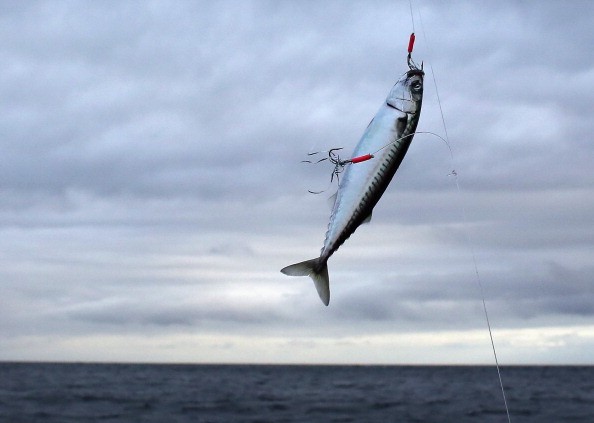On Pawleys Island in South Carolina, a fisherman caught a huge king mackerel off the pier. The taxman interrupted him before he could land it. The taxman, in this case, was a large bull shark that destroyed the fisherman's success in taking home his catch.
Sharks are known as the tax man within the fishing community due to their propensity to take a percentage of their hard-earned harvests (per USA Today).
Unfortunately, a video John Harrison shared with WPDE show that the fisherman's whole catch was taken by the taxman.
 (Photo : Photo by Matt Cardy/Getty Images)
(Photo : Photo by Matt Cardy/Getty Images)
CADGWITH, ENGLAND - SEPTEMBER 05: A mackerel is caught on a line from the fishing boat Silver Queen, close to the Lizard penisula, as they take part in the final Cadgwith Cove fortnightly fishing competition of the year, in Cadgwith on September 5, 2013 in Cornwall, England.

CADGWITH, ENGLAND - SEPTEMBER 05: A mackerel is caught on a line from the fishing boat Silver Queen, close to the Lizard penisula, as they take part in the final Cadgwith Cove fortnightly fishing competition of the year, in Cadgwith on September 5, 2013 in Cornwall, England.
'Taxman' Bull Shark Steals Mackerel From Fisherman
The angler brings the king mackerel to the surface in the Facebook video. Jim's companion can be heard in the video saying, "Get the gaff, get the gaff, get the graff, nice king. Don't mess this up, Jim."
When the gaff was eventually lowered toward the fish, a bull shark surfaced, grabbed it by the tail, and swam away.
Other fishers felt Jim's pain when he encountered the taxman.
"Got to pay the tax man," one commented.
Another Facebook user jokingly wrote that the taxman never takes a day off.
The tax man will always collect, a third person added. "Time to pay your dues," another suggested.
@facebook|https://www.facebook.com/WPDEABC15/videos/378701280914275/@
Mackerel Characteristics
Britannica mentioned that mackerels have rounded, torpedo-shaped bodies, a forked tail, a row of tiny finlets behind the dorsal and anal fins, and a thin, keeled tail base. They are carnivorous fish that eat tiny fish, plankton, crustaceans, mollusks, and fish eggs.
The prolific and commercially significant common mackerel (Scombrus scombrus) of the Atlantic Ocean can occasionally be seen in massive schools.
It is silver-white below and blue-green above, with a length of around 30 cm (12 inches), and it has several wavy, dark, vertical lines on the top sides. It lacks an air bladder and has two short keels on either side of the base of the tail in addition to two well-separated dorsal fins.
North Atlantic Ocean's shores - from North Carolina to Labrador and Spain to Norway - are home to the common mackerel.
About Bull Sharks
Bull sharks, according to National Geographic, are dangerous, abundant, and frequently found close to densely populated places, such as tropical shorelines. They travel far inland via rivers and tributaries and remain unaffected by brackish or freshwater.
Many scientists believe the said species are the most dangerous sharks in the world because of the traits mentioned above. They have historically been joined as the three species most likely to attack people by their well-known cousins, great whites and tiger sharks.
Bull sharks got their names from their short, blunt snouts, brawny personalities, and propensity to headbutt their victims before attacking. They are medium-sized sharks with large pectoral fins and thick, sturdy bodies. Particularly in adolescent bull sharks, the fins have black tips and are gray on top and white underneath.
Bull sharks are heavily hunted for their flesh, skins, and oils. Their population is declining and average lengths have dramatically decreased during the previous three decades, according to one research obtained by National Geographic.
RELATED ARTICLE: Shark Encounters May Rise as Apex Predators Thrive in Urbanized Coastal Cities in Miami: Study
Check out more news and information on Animals in Science Times.










!['Cosmic Glitch' in Einstein's Theory of General Relativity Could Be Explained in This New Scientific Tweak [Study]](https://1721181113.rsc.cdn77.org/data/thumbs/full/53435/258/146/50/40/cosmic-glitch-in-einsteins-theory-of-general-relativity-could-be-explained-in-this-new-scientific-tweak-study.jpeg)



